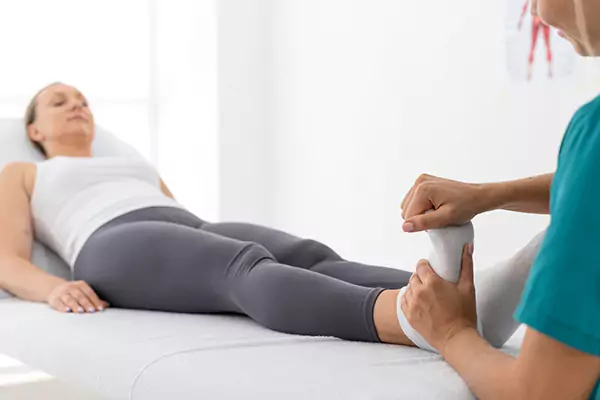MJ Naidu Super Speciality Hospital
- Home
- /
- Paediatric Orthopaedics 2
Paediatric Orthopedics

- 24HRS TRAUMA SERVICE
-
24HRS DIGITAL X-RAY / MRI/CT / USG / X-RAY /
DOPPLER /ECHO - 24HRS LABORATORY
- 24HRS PHARMACY
- 24HRS AMBULANCE SERVICE
- INTENSIVE CARE UNIT
- CASUALTY DEPARTMENT
- FULLY EQUIPPED OPERATION THEATER (2 LAMINAR )
Best Pediatric Orthopaedic Surgeon In Vijayawada
Why Pediatric Orthopedics Matters
The musculoskeletal system plays a pivotal role in a child’s growth and development. Any issues that arise during this crucial phase can have a lasting impact on their overall well-being. Pediatric orthopedic specialists are trained to address these issues with precision and compassion.
Here are some key reasons why pediatric orthopedics matters:
Growth and Development: Children’s bones, muscles, and joints are still growing and developing. Identifying and treating musculoskeletal issues early can ensure proper growth and prevent long-term problems.
Specialized Care: Pediatric orthopedic surgeons have extensive training and experience in treating children. They understand the unique needs of young patients and can provide age-appropriate care.
Improved Quality of Life: Timely intervention can alleviate pain, improve mobility, and enhance the quality of life for children with orthopedic conditions.


Common Pediatric Orthopedic Conditions
Pediatric orthopedics encompasses a wide range of conditions.
Here are some of the most common ones we encounter at MJ Naidu Super Specialty Hospitals:
Developmental Dysplasia of the Hip (DDH): DDH is a condition where the hip joint doesn’t develop properly. Early detection and treatment are crucial to prevent hip problems in the future.
Scoliosis: Scoliosis is a condition that results from abnormal curvature of the spine. It can be congenital or develop during childhood. Regular monitoring and, if needed, bracing or surgery can help manage scoliosis.
Clubfoot: Clubfoot is a congenital condition where a baby’s foot is twisted or pointed inward. Non-surgical techniques like casting and stretching are effective in most cases.
Cerebral Palsy (CP): CP is a neurological disorder that can affect muscle control and movement. Orthopedic interventions, such as surgery or bracing, can help improve mobility and function.
Fractures and Trauma: Children are prone to fractures and injuries during play and sports. Pediatric orthopedic specialists are skilled in treating these injuries with a focus on promoting proper healing and preventing complications.
Juvenile Idiopathic Arthritis (JIA): Juvenile Idiopathic Arthritis is a condition that affects children. It can cause joint pain and inflammation. Early diagnosis and treatment are essential to manage symptoms and prevent joint damage.
Limb Length Discrepancy: Some children may have one leg longer than the other, leading to gait abnormalities. Treatment options include shoe lifts or, in severe cases, surgery.
Osteogenesis Imperfecta (OI): OI, often referred to as “brittle bone disease,” is a genetic condition that causes fragile bones. Orthopedic care focuses on minimizing fractures and improving bone density.
Diagnostic and Treatment Options
Pediatric orthopedic specialists use a variety of diagnostic tools and treatment options tailored to each child’s unique needs.
These may include:
Physical Examination: A thorough physical examination is often the first step in diagnosing musculoskeletal issues in children.
Imaging Studies: X-rays, ultrasound, MRI, and CT scans can provide detailed images of bones, joints, and soft tissues, helping in accurate diagnosis.
Bracing and Casting: Non-surgical treatments like bracing and casting are often used to correct alignment issues, such as in scoliosis or clubfoot.
Physical Therapy: Physical therapy plays a crucial role in improving mobility, strength, and function for many pediatric orthopedic conditions.
Surgery: When necessary, pediatric orthopedic surgeons perform minimally invasive or traditional surgical procedures to correct structural abnormalities or injuries.
Medications: Some conditions, like JIA, may require medication to reduce inflammation and manage symptoms.
Orthotics and Prosthetics: Custom-made orthotic devices or prosthetics can enhance mobility and improve the quality of life for children with limb-related issues.


The Importance of Early Intervention
Early intervention is a cornerstone of pediatric orthopedic care. Detecting and addressing musculoskeletal issues during childhood can prevent complications and improve outcomes.
Here’s why it matters:
Maximizing Growth Potential: Treating conditions like DDH or limb length discrepancies early can ensure that a child’s bones and joints grow properly.
Pain Management: Early treatment can alleviate pain and discomfort, allowing children to lead more active and enjoyable lives.
Preventing Secondary Complications: Some conditions, if left untreated, can lead to secondary complications like joint deformities or muscle contractures. Early intervention can prevent these issues.
Emotional Well-being: Children with orthopedic conditions may experience emotional challenges. Early treatment can improve self-esteem and psychological well-being.
Our Approach at MJ Naidu Super Specialty Hospital
At MJ Naidu Super Specialty Hospital, we take a multidisciplinary approach to pediatric orthopedic care. Our team of dedicated specialists, including pediatric orthopedic surgeons, physical therapists, and nurses, work together to provide the best care for your child.
Following steps outline the procedure we follow at MJ Naidu Super Specialty Hospital:
Comprehensive Evaluation: We start with a thorough evaluation to understand your child’s condition and needs fully.
Personalized Treatment: Our treatment plans are tailored to each child, taking into account their age, growth stage, and specific condition.
Family-Centered Care: We believe in involving families in the care process, ensuring you have the information and support you need.
Minimally Invasive Techniques: Whenever possible, we utilize minimally invasive techniques to reduce discomfort and promote faster recovery.
Rehabilitation Services: Our rehabilitation team plays a critical role in helping children regain strength, mobility, and independence.

Conclusion
Pediatric orthopedics is a specialized field that plays a vital role in ensuring the musculoskeletal health and well-being of children. At [Hospital Name], we are committed to providing the highest level of care to young patients and their families. If you have concerns about your child’s musculoskeletal health or are seeking treatment for a specific condition, we are here to support you every step of the way. Contact us today to schedule a consultation and take the first step toward ensuring your child’s healthy growth and development.

